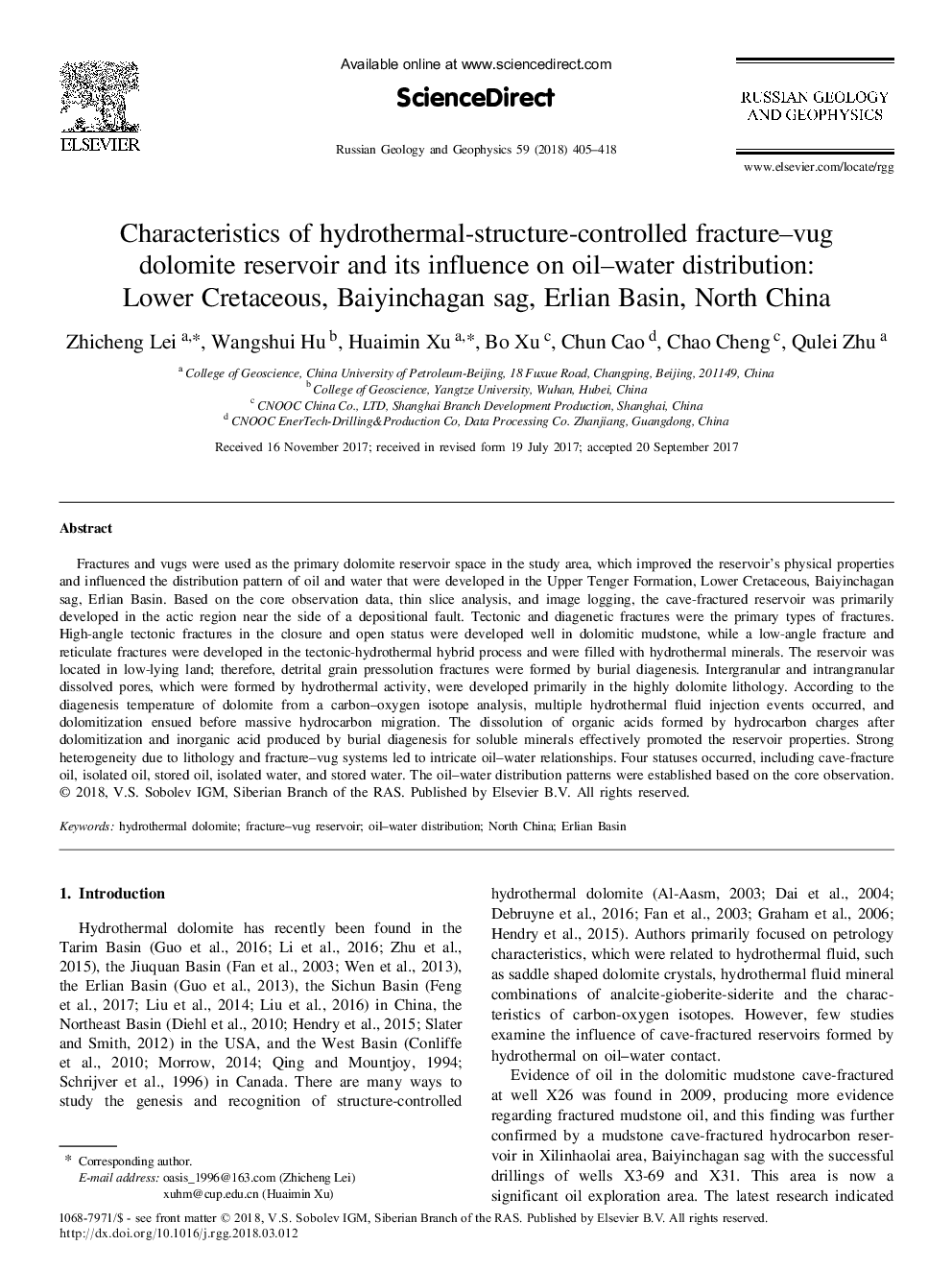| کد مقاله | کد نشریه | سال انتشار | مقاله انگلیسی | نسخه تمام متن |
|---|---|---|---|---|
| 8915191 | 1641035 | 2018 | 14 صفحه PDF | دانلود رایگان |
عنوان انگلیسی مقاله ISI
Characteristics of hydrothermal-structure-controlled fracture-vug dolomite reservoir and its influence on oil-water distribution: Lower Cretaceous, Baiyinchagan sag, Erlian Basin, North China
ترجمه فارسی عنوان
ویژگی های مخزن دولومیت شکست خورده خرد شده تحت کنترل هیدروترمال ساختاری و تأثیر آن بر توزیع آب و نفت: کرتاسه پایین، بویین چاگان، سواحل ارلیان، شمال چین
دانلود مقاله + سفارش ترجمه
دانلود مقاله ISI انگلیسی
رایگان برای ایرانیان
کلمات کلیدی
دولومیت هیدروترمال مخزن شکست خورده توزیع نفت و آب، شمال چین، حوضه ارلیان،
ترجمه چکیده
شکستگی ها و لکه ها به عنوان فضای مخزن اصلی دولومیت در منطقه مورد مطالعه مورد استفاده قرار گرفتند که ویژگی های فیزیکی مخزن را بهبود بخشید و بر الگوی توزیع نفت و آب که در سازند بالا تانگر، کرتاسه پایین، بویینچگان سنبله، حوض ارلیان توسعه یافت، تحت تأثیر قرار گرفت. بر اساس داده های مشاهده ی اصلی، تجزیه و تحلیل تکه های نازک و ورود به تصویر، مخزن غار مخروطی عمدتا در ناحیه اکتیو در نزدیکی خط گسل رسوب ایجاد شده است. شکستگی های زمینی و دیگنتیک، نوع اصلی شکستگی بودند. شکستگی های زمین لرزه ای با زاویه دید بالا در بستر و وضعیت باز به خوبی در گرادیان دولومیتی توسعه یافت، در حالی که شکستگی ضعیف زوج و شکستگی های شبکیه در فرآیند ترکیبی تکتونیکی-هیدروترمال توسعه یافت و با مواد معدنی هیدروترمال پر شده است. مخزن در زمین های کم ارتفاع قرار داشت؛ بنابراین، شکستگی های فشرده سازی دانه های خالص از طریق دیاگنس دفن زدایی تشکیل شده است. منافذ انحلال درون گرانول و درون گرانشی که از طریق فعالیت هیدروترمال تشکیل شده است، در درجه اول در سنگ شناسی دولومیت بالا توسعه یافت. با توجه به درجه حرارت دیگنوز از دولومیت از تجزیه و تحلیل ایزوتوپ کربن-اکسیژن، چند رویداد تزریق سیال هیدروترمال رخ داده است، و قبل از مهاجرت عظیم هیدروکربن دولومیتیزاسیون رخ داده است. انحلال اسیدهای آلی تشکیل شده توسط اتهامات هیدروکربنی پس از دولومیتیزاسیون و اسید معدنی تولید شده توسط دیاژنوز دفن برای مواد معدنی محلول به طور موثر خواص مخزن را افزایش داد. ناهمگونی شدید به علت سنگ شناسی و سیستم های شکستگی-خم شدن منجر به پیچیدگی روابط نفت و آب شد. چهار وضعیت رخ داده است، از جمله روغن شکستن غار، روغن جدا شده، نفت ذخیره شده، آب جدا شده و آب ذخیره شده. الگوهای توزیع نفت-آب بر اساس مشاهدات هسته ای ایجاد شده است.
موضوعات مرتبط
مهندسی و علوم پایه
علوم زمین و سیارات
زمین شناسی
چکیده انگلیسی
Fractures and vugs were used as the primary dolomite reservoir space in the study area, which improved the reservoir's physical properties and influenced the distribution pattern of oil and water that were developed in the Upper Tenger Formation, Lower Cretaceous, Baiyinchagan sag, Erlian Basin. Based on the core observation data, thin slice analysis, and image logging, the cave-fractured reservoir was primarily developed in the actic region near the side of a depositional fault. Tectonic and diagenetic fractures were the primary types of fractures. High-angle tectonic fractures in the closure and open status were developed well in dolomitic mudstone, while a low-angle fracture and reticulate fractures were developed in the tectonic-hydrothermal hybrid process and were filled with hydrothermal minerals. The reservoir was located in low-lying land; therefore, detrital grain pressolution fractures were formed by burial diagenesis. Intergranular and intrangranular dissolved pores, which were formed by hydrothermal activity, were developed primarily in the highly dolomite lithology. According to the diagenesis temperature of dolomite from a carbon-oxygen isotope analysis, multiple hydrothermal fluid injection events occurred, and dolomitization ensued before massive hydrocarbon migration. The dissolution of organic acids formed by hydrocarbon charges after dolomitization and inorganic acid produced by burial di agenesis for soluble minerals effectively promoted the reservoir properties. Strong heterogeneity due to lithology and fracture-vug systems led to intricate oil-water relationships. Four statuses occurred, including cave-fracture oil, isolated oil, stored oil, isolated water, and stored water. The oil-water distribution patterns were established based on the core observation.
ناشر
Database: Elsevier - ScienceDirect (ساینس دایرکت)
Journal: Russian Geology and Geophysics - Volume 59, Issue 4, April 2018, Pages 405-418
Journal: Russian Geology and Geophysics - Volume 59, Issue 4, April 2018, Pages 405-418
نویسندگان
Zhicheng Lei, Wangshui Hu, Huaimin Xu, Bo Xu, Chun Cao, Chao Cheng, Qulei Zhu,
